Home | Airshows | The Hangar | Nostalgia | Links
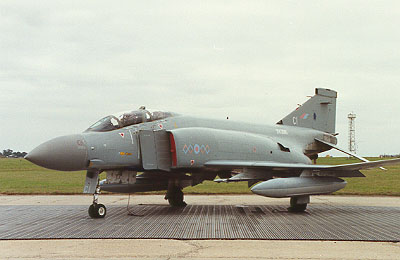 Part
Six: Phinal curtain for the boys in blue
Part
Six: Phinal curtain for the boys in blue
Events in the eastern bloc, long thought to be from where the threat to air defence would come, were to have an effect on the Phantom which nobody foresaw. The collapse of the Warsaw pact and resultant arms reduction treaties meant that the Phantom was sacrificed. Planned to continue to 2007, to be replaced one assumes by Typhoon, the necessity for two fighter squadrons in RAF Germany and nine in the UK could no longer be justified, especially as Tornado F3s, designed to fulfil the long range patrol, were also available – with supposedly better kit. The Leuchars wing re-equipped with the F3, with its venerable FG1/ FGR2 mix of Phantoms returning to storage at Wattisham, for possible re-sale or to provide a pool of airframes for the remaining squadrons. Anyone who saw the way that the aircraft were stored in Number 1 hangar knew that there was no way these aircraft were going anywhere.
The Phantom OCU at Leuchars,
shadow numbered 64 Squadron, also disappeared, some of the airframes finding
their way to Wattisham to form the Phantom Training Flight, annexed to
74 Squadron. 74 Squadron's tenure of the F-4J drew rapidly to a close
as the entire fleet standardised on the now available 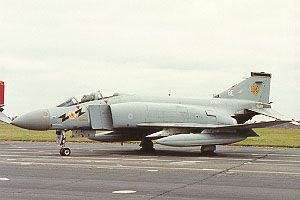
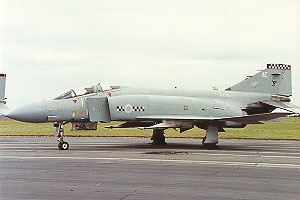 FGR2
model in early 1991. Sometimes the most spectacular events go un-noticed,
such was the case when one January morning 74 launched nine F-4Js for
a last diamond-nine over the local area. Landing on 05 runway, the aircraft
taxied back to their HAS site each in turn folding its wings – something
that no other Phantom units in the RAF could have done – wing folding
FGR2
model in early 1991. Sometimes the most spectacular events go un-noticed,
such was the case when one January morning 74 launched nine F-4Js for
a last diamond-nine over the local area. Landing on 05 runway, the aircraft
taxied back to their HAS site each in turn folding its wings – something
that no other Phantom units in the RAF could have done – wing folding
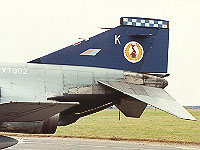
 being
a cockpit controlled action only available in the F-4J. Time was running
out for all the Phantoms though, as once more the scrap dump at Wattisham
started to fill with hulks of the now stripped FG1s from 43 and 111 Squadrons.
RAF Germany lost its two interceptor squadrons as the German Air Force,
now re-unified, ceased to have a QRA requirement. The ex-19 and 92 Squadron
machines also came back to Wattisham so that by early 1991 all the Phantom
airframes were located here.
being
a cockpit controlled action only available in the F-4J. Time was running
out for all the Phantoms though, as once more the scrap dump at Wattisham
started to fill with hulks of the now stripped FG1s from 43 and 111 Squadrons.
RAF Germany lost its two interceptor squadrons as the German Air Force,
now re-unified, ceased to have a QRA requirement. The ex-19 and 92 Squadron
machines also came back to Wattisham so that by early 1991 all the Phantom
airframes were located here.
July 1991 saw a sight over Wattisham that, a few years earlier, would have meant that we had lost the war! The collapse of the Warsaw pact had led to hands of friendship being extended to Iron Curtain countries, and the pending Tiger meet at Fairford IAT ’91 was an ideal opportunity. Escorted by the obligatory Tiger marked Phantoms, a Mig-23, two Mig-29s, two L39s, an An12 and Tu154 of the Czech Air Force appeared on approach. To someone who had lived his life in the shadow of this airfield, and all the events that had taken place there, I have to say that this was the most memorable aviation moment of my life. To see Mig fighters over one’s home sent a chill, but also a thrill, to the spine.
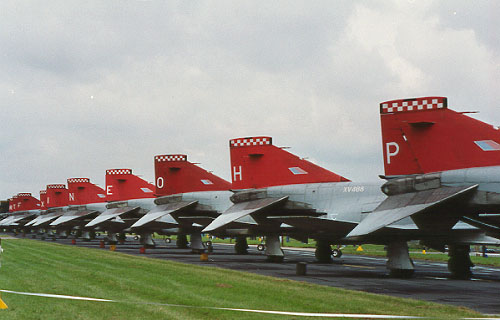 1992
was the phinal year of the Phantom. It was also one of the most spectacular
years in the Wattisham skies. 56 Squadron was the first to go, but not
before a photo call was held, with pride of place going to 56 emblem adorned
Lightning F6 XP693 (courtesy of BAe), Phantom and Tornado F3. This showed
the Firebird would still grace a RAF Fighter, the OCU at Coningsby being
re-numbered from 65 (R) Squadron to 56 (R) Squadron to preserve the Squadron
number with the 'greater' heritage.
1992
was the phinal year of the Phantom. It was also one of the most spectacular
years in the Wattisham skies. 56 Squadron was the first to go, but not
before a photo call was held, with pride of place going to 56 emblem adorned
Lightning F6 XP693 (courtesy of BAe), Phantom and Tornado F3. This showed
the Firebird would still grace a RAF Fighter, the OCU at Coningsby being
re-numbered from 65 (R) Squadron to 56 (R) Squadron to preserve the Squadron
number with the 'greater' heritage.
Phantoms of other units came to say farewell, including German and United States Air Forces. A line-up on the taxiway showed all the resident Phantoms of 56 Squadron (in order P H O E N I X F T R) and 74 Squadron (T I G E R S Q N). Most will remember the day though for the torrential storm that hit Wattisham in the early afternoon, but not before some spectacular shots were had against the threatening black skies.
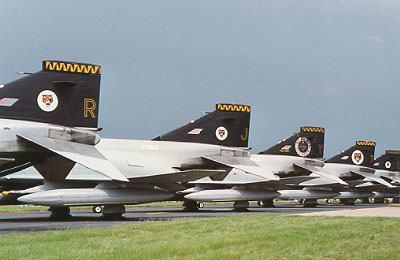 74
Squadron had won a fly-off with 56 Squadron during the early spring to
select a crew to demonstrate the solo Phantom at air-shows in its final
year. Squadron Leader Archie Liggatt and Flt Lt Mark Mainwaring were selected,
and presented with two newly painted Phantoms for this task. An opportunity
was missed in that the colour scheme chosen was conservative to say the
least, especially when compared with continental display machines (KLu
F-16, etc.). The team displayed locally at North Weald, Mildenhall, Lakenheath,
Honington and the final Bentwaters display as well as many other parts
of the UK and Europe.
74
Squadron had won a fly-off with 56 Squadron during the early spring to
select a crew to demonstrate the solo Phantom at air-shows in its final
year. Squadron Leader Archie Liggatt and Flt Lt Mark Mainwaring were selected,
and presented with two newly painted Phantoms for this task. An opportunity
was missed in that the colour scheme chosen was conservative to say the
least, especially when compared with continental display machines (KLu
F-16, etc.). The team displayed locally at North Weald, Mildenhall, Lakenheath,
Honington and the final Bentwaters display as well as many other parts
of the UK and Europe.
74 Squadron HAS site was to the west side of Wattisham, and their aircraft had to taxi past Crash Gate 2 to get to or from the runway. Aircraft distance from 'spectators' was a mere 70 yards or so and much playing to the crowd (which was reciprocated with some enthusiasm) took place in those days. Spotters were always treated well by the RAF at Wattisham, and this crash gate became the second home to an increasing band of anoraks. It has to be said that the flying became superfluous to the banter on occasions, and it was often darkness or the oncoming chill that sent us home rather than the fact that the base had shut some hours before. Exercises led to many days holidays being taken – just to 'sit on the wire'. Elder Forests, Priories and Hammers gave the only excuse necessary for supplies to be bought, flasks to be filled and scanner batteries to be checked.
 Wattisham
had the honour of providing the Royal Flypast at the annual celebration
of the Queen's birthday in June, and so did it style, sending up no fewer
than sixteen in formation. Reminiscent of those
halcyon Hunter days, the glorious summer sun during the week preceding
the flypast afforded plenty of practice time, much to the delight of the
locals! Later, in July, 74 Squadron held their last Families Day. The
crowds of on-lockers outside the base had rarely been exceeded. A four-ship
was flown by the Squadron, along with displays from the Battle of Britain
Memorial Flight, Tornado GR1, F3 and others. Pride of place went to the
solo display from Archie Liggatt and Mark Mainwaring. Un-noticed by the
display team was the loss of a large piece of wing skin, which fell harmlessly
to the official visitors on the airfield but perilously close to the onlookers
in the surrounding fields.
Wattisham
had the honour of providing the Royal Flypast at the annual celebration
of the Queen's birthday in June, and so did it style, sending up no fewer
than sixteen in formation. Reminiscent of those
halcyon Hunter days, the glorious summer sun during the week preceding
the flypast afforded plenty of practice time, much to the delight of the
locals! Later, in July, 74 Squadron held their last Families Day. The
crowds of on-lockers outside the base had rarely been exceeded. A four-ship
was flown by the Squadron, along with displays from the Battle of Britain
Memorial Flight, Tornado GR1, F3 and others. Pride of place went to the
solo display from Archie Liggatt and Mark Mainwaring. Un-noticed by the
display team was the loss of a large piece of wing skin, which fell harmlessly
to the official visitors on the airfield but perilously close to the onlookers
in the surrounding fields.
Phinal phling came on 14 September when a mini Tiger meet was held at Wattisham for the first and only time. Visitors included soon-to-be-gone Fiat G91s from the Portuguese Air Force, Super Etendards from the Aeronavale, F111Es from the 20th TFW USAF and a KC135E from the Air National Guard. Many had retained their Tiger Schemes from previous meets, bringing some seldom seen colour to the Suffolk skies. Wattisham had the best paint job on the airfield, only problem being it was on XV404 which had been grounded for some time...if only the display aircraft had been painted like it! The meet also gave us our first glimpse of Hawks painted in 74(R) Squadron colours, hitting home how close disbandment was for the Phantom fleet.
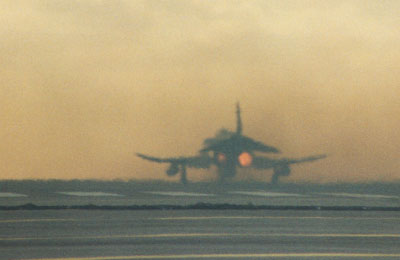 Although
mooted at the end of the Lightning era, it never seemed possible that
Wattisham, the place where I had spent so many happy days, enjoying my
hobby, would ever close. Growth of Stansted as London's third airport
was squeezing airspace in North Essex and Suffolk and the Phantoms became
ever more restricted in where they could play, more often than not heading
for the expanses of the North Sea. Announcement came late in 1991 that
the Phantoms were to leave, and that 'an alternative military use' would
be found for the base. Speculation as to what this could be was rife,
ranging from being put into mothballs pending Eurofighter's arrival, to
complete closure. Most reckoned on a forward operating base for the Leuchars
F3s, which would have occasionally brought Treble-One back to its proper
home, but finally the announcement came that the Army were to move in
to form an Airmobile Brigade with displaced helicopter regiments from
Germany. It was very much a mixture of feelings, relief that the airfield
was to be kept alive and not rot away but heavy, deep disappointment that
the days of thunder were over.
Although
mooted at the end of the Lightning era, it never seemed possible that
Wattisham, the place where I had spent so many happy days, enjoying my
hobby, would ever close. Growth of Stansted as London's third airport
was squeezing airspace in North Essex and Suffolk and the Phantoms became
ever more restricted in where they could play, more often than not heading
for the expanses of the North Sea. Announcement came late in 1991 that
the Phantoms were to leave, and that 'an alternative military use' would
be found for the base. Speculation as to what this could be was rife,
ranging from being put into mothballs pending Eurofighter's arrival, to
complete closure. Most reckoned on a forward operating base for the Leuchars
F3s, which would have occasionally brought Treble-One back to its proper
home, but finally the announcement came that the Army were to move in
to form an Airmobile Brigade with displaced helicopter regiments from
Germany. It was very much a mixture of feelings, relief that the airfield
was to be kept alive and not rot away but heavy, deep disappointment that
the days of thunder were over.
 People
I had met over the years at Crash Gate 2 had not only taught me a great
deal (serial collecting, scanners, telephoto lenses) but had helped me
through a particularly rough period of my life, and for that I will always
be grateful. Together we could look back over Elder Forests, Priories,
and TACEVALs of the past and remember the thrill those days gave us along
with the frustrations. No-one who has not sat in the rain for two days
can possibly understand how it feels to be told "they all went to
Leuchars!" Likewise, however, they will not comprehend the thrill
when, having heard a raid call in on the scanner with that lovely word
Tango, you see a series of dark smoke trails in the clear distance,
and know that "the Spangs are coming!" If you don’t know
what that means – you were not there!
People
I had met over the years at Crash Gate 2 had not only taught me a great
deal (serial collecting, scanners, telephoto lenses) but had helped me
through a particularly rough period of my life, and for that I will always
be grateful. Together we could look back over Elder Forests, Priories,
and TACEVALs of the past and remember the thrill those days gave us along
with the frustrations. No-one who has not sat in the rain for two days
can possibly understand how it feels to be told "they all went to
Leuchars!" Likewise, however, they will not comprehend the thrill
when, having heard a raid call in on the scanner with that lovely word
Tango, you see a series of dark smoke trails in the clear distance,
and know that "the Spangs are coming!" If you don’t know
what that means – you were not there!
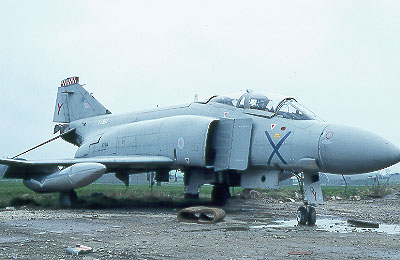 Closure
did come, though, and as the scrap dump over near Nedging Tye became more
populated, first 56 Squadron then the other stored aircraft made their
'phinal' journey. I would like to think that the powers that be had a
heart, but to see these giant beasts, who would daily defy gravity and
leap to the sky that was theirs, reduced by chain saws to a mass of broken
aluminium alloys proved otherwise. This was the first time I had liked
the American idea of tipping their aircraft over the side of a carrier
– it is somehow more dignified. I know we cannot keep them all, but
today we watch as even the ones we did keep are slowly condemned to the
smelter.
Closure
did come, though, and as the scrap dump over near Nedging Tye became more
populated, first 56 Squadron then the other stored aircraft made their
'phinal' journey. I would like to think that the powers that be had a
heart, but to see these giant beasts, who would daily defy gravity and
leap to the sky that was theirs, reduced by chain saws to a mass of broken
aluminium alloys proved otherwise. This was the first time I had liked
the American idea of tipping their aircraft over the side of a carrier
– it is somehow more dignified. I know we cannot keep them all, but
today we watch as even the ones we did keep are slowly condemned to the
smelter.
Planes may die, but squadrons live on. It was some consolation on that day in October 1992 to know that the phoenix of 56 Squadron was continuing to fly at Coningsby. 74 Squadron hung its standard in the church at Ringshall, where it is today and will stay, overlooking that flight path for so long the way home for its pilots. A new standard was awarded and flew off to Valley in Anglesey, in a similar role to its compatriots of 56, to train the pilots of the future, until disbandment again came in 2000.

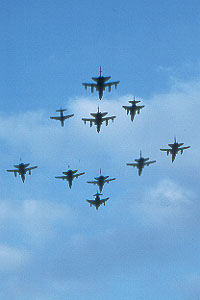 31
October 1992 was the day when RAF Wattisham stood down as a fighter base.
Representative aircraft from units that had spent time there were to fly,
one last time, in a formation over the field. Rarely has the fence been
so crowded as it was that day. Led by a sole Phantom
FGR2 in 74 Squadron colours a mix of Hawk, Tornado and Jaguar flew over
the control tower before departing the base. That left only the few jets
assembled as a static display to go. The honour of being the last aircraft
to leave RAF Wattisham before it closed for flying went to Jaguar XZ398,
piloted by the Commanding Officer of 41 Squadron. As quiet settled over
the base and spotters were left to their thoughts, that lone Phantom –
having led the formation – returned. A Mach 0.9 pass followed a touch-and-go
into the vertical before landing – the last time a Phantom would
do so here.
31
October 1992 was the day when RAF Wattisham stood down as a fighter base.
Representative aircraft from units that had spent time there were to fly,
one last time, in a formation over the field. Rarely has the fence been
so crowded as it was that day. Led by a sole Phantom
FGR2 in 74 Squadron colours a mix of Hawk, Tornado and Jaguar flew over
the control tower before departing the base. That left only the few jets
assembled as a static display to go. The honour of being the last aircraft
to leave RAF Wattisham before it closed for flying went to Jaguar XZ398,
piloted by the Commanding Officer of 41 Squadron. As quiet settled over
the base and spotters were left to their thoughts, that lone Phantom –
having led the formation – returned. A Mach 0.9 pass followed a touch-and-go
into the vertical before landing – the last time a Phantom would
do so here.
The valiant few assembled back at the wire the next day, Saturday, to witness one last sad sight. The last two Phantoms, accompanied by a Hawk, taxied out and took off. The tower roof and ASP was crowded to an extent that I could not ever recall before. Several passes were made, and finally the Hawk departed, followed by one of the Phantoms – destined for Duxford. The scene played out the day before was repeated – a touch-and-go followed by a burner pass, and climb into the blue yonder.
It was over. There were regulars there that day that I have never seen since, but the emotion, in the late autumn sun, was touchable. You had to have been there!
Life for Wattisham would change dramatically, with the arrival of the boys in khaki -see part seven.
Home | Airshows | The Hangar | Nostalgia | Links